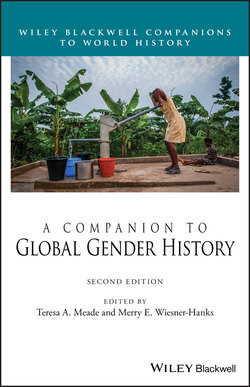Читать книгу A Companion to Global Gender History - Группа авторов - Страница 33
Introduction
ОглавлениеThis chapter investigates how gender ideology and gendered identities are given materiality in ritual and myth. I use “myth” and “mythology” to mean meaningful narratives for those who adhere to the myth, rather than untruth or superstition. I also do not take myth to be the opposite of history, as both are narratives by which truth is seen to be disseminated. In this I follow Hayden White (1987). Gender ideology and its performance mark the boundaries for, and of, imagined communities (Anderson, 2006), while imagined flesh made material in genitals comprises the somatic canvas upon which gender ideology is marked, defined, and performed. The matter of flesh within the imaginary system of human knowing “stabilizes over time to produce the effect of boundary, fixity, and surface” (Butler, 1993: 9). The marking, defining, and performing of gender ideology and gendering are deployed through and enacted in the media of ritual and myth. I use the term “media” in the sense of sites for the public dissemination and circulation of information, knowledge, and truths. In critical theory, from within which I work, media are the means and ways that meaning is inscribed and messages sent. Ritual and myth are the ordering systems, the media, through which signals and signs are sent (Morley, 2005: 214).
Deployment and enactment in these kinds of media give biological, social, and metaphysical credence to gender ideologies and their performance. Equally, flesh marked by gender can also be further marked by any one or more of: indigeneity, race, age, geopolitical location, ablebodiedness, and sexuality. Such multiple markings play out in terms of what black and poststructural feminists refer to as intersectionality (Collins and Bilge, 2016; May, 2015; Lutz, Vivar, and Supik, 2011; Crenshaw, 1991; see also Chapter 6 by Keenan in this volume). By examining the imaginative development of gender ideology and its performance as acquired, maintained, and idealized through these media, critical theorists are better able to comprehend, chart, weigh, and interrupt gender ideology.
To critically engage gender ideology in this chapter, I discuss rites and myths of circumcision to make visible how the media of ritual and myth are central to the construction and maintenance of gender ideology. Both female and male circumcision are highly contested practices (Ahmadu, 2000; Gollaher, 2000; Knight 2001; Shear, Hart, and Diekema, 2012; Theisen, 2012; Wambura, 2018; Wyatt, 2009; see also Chapter 33 by Redding in this volume). For the purposes of this chapter, however, examining the construction of gender in ritual and myth, I have not taken up the arguments for or against ritual circumcision. The rites and myths chosen for analysis in this chapter are derived from the Mende folk of Sierra Leone who continue to practice circumcision as a rite of passage for youth into adulthood. The ritual of circumcision is explicit in its effort to construct a new identity, making it an excellent rite by which to think about gender. The rite of circumcision is an ancient rite and among some of the earliest organized rituals. In my work in ritual, myth, and semiotics, I draw on the systems of belief and practice of indigenous folks in Africa, Cuba, and North and South America (along with ancient near Eastern and Mediterranean myths, rituals, and symbols) as their worlds and world constructions are too often absent in the study of religion, not fitting the normative model of “religion” represented by the so‐called world religions of Christianity, Judaism, Islam, Buddhism, Hinduism, and Confucianism (Paden, 1994). Examining indigenous systems to think about ritual, myth, and symbol gives credence to their world constructions.
